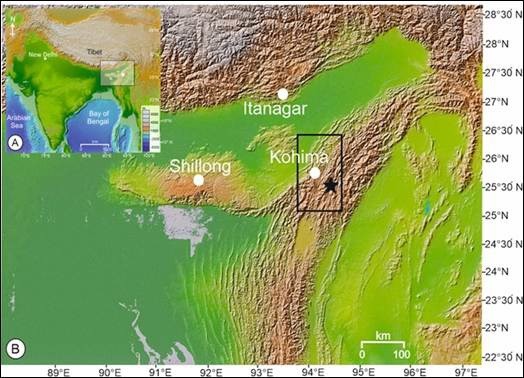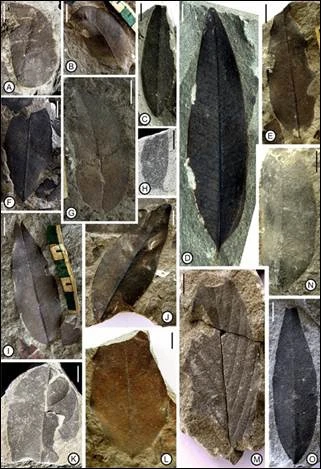Locality in Nagaland (marked by star) from where the fossil leaves were collected.

Fossil leaves in Nagaland reveal Antarctic ice’s role in shaping Indian monsoon
Morung Express News
Dimapur | September 11
Fossilised leaves from the hills of Nagaland are offering a rare glimpse into how Earth’s distant past shaped one of South Asia’s defining weather systems, informed new study highlighted by the Union Ministry of Science and Technology.
The leaves, showing that the formation of Antarctica’s massive ice sheets about 34 million years ago, helped set the stage for the Indian monsoon, it said.
The fossils were recovered from Laisong Formation - a band of rock in Nagaland dating to the late Eocene–early Oligocene, about 34 million years ago, the Ministry noted in a statement on September 9. Part of the Barail Group, it consists of layers of sandstone, siltstone and shale laid down in river deltas and shallow seas.
As it was formed during the same period as Antarctica’s first major ice sheets, it preserves leaves and other fossils that act as a detailed archive of the climate and environment in North-East India at that time, it added.
The Ministry release noted that at that time “the region once had a warm and wet climate,” very different from today.
To understand why, scientists from the Birbal Sahni Institute of Palaeosciences in Lucknow and the Wadia Institute of Himalayan Geology in Dehradun analysed the specimens using a technique called the Climate Leaf Analysis Multivariate Program, or CLAMP.

This method looks at the size, shape and edges of fossil leaves to infer past temperature and rainfall. Larger leaves with smooth edges usually grow in warm, wet climates; smaller, toothed leaves indicate cooler, drier conditions.
The analysis for Nagaland pointed to much higher rainfall and temperatures than the region experiences now, conditions that would have supported dense tropical forests, the statement said.
What made the finding stand out was the timing of the fossils, about 34 million years old and exactly when scientists know that Antarctica’s first large ice sheets were forming.
The Ministry said this “pointed to a global connection — suggesting that the growth of Antarctic ice may have shifted wind and rainfall patterns, bringing intense monsoonal rains to Northeast India.”
The study, published in Palaeogeography, Palaeoclimatology, Palaeoecology, argues that Antarctic glaciation changed global air circulation by moving the Intertropical Convergence Zone (ITCZ), a band of low pressure near the equator where trade winds meet and humid air rises, producing heavy rains.
Its position controls much of the tropics’ rainfall, including the monsoon. As the ice sheets grew, the ITCZ appears to have shifted northward, intensifying rain over what is now India, it said.
For Nagaland, the work underscores how its fossil record connects to global climate events. The Laisong Formation’s leaves are a tangible link between the frozen deserts of Antarctica and the monsoon belt of South Asia, showing how changes at one pole reverberated across continents and helped trigger the system that still defines India’s seasons.
The Ministry also stressed the modern relevance of the finding noting that as climate change accelerates the melting of Antarctic ice, the ITCZ may shift again, potentially disrupting rainfall patterns across the tropics.
This could lead to profound changes in the monsoon, which is vital for India's agriculture, water supply, and the livelihoods of millions, it added.
The study serves as a crucial reminder of the interconnectedness of global climate systems and the need to understand Earth's past to prepare for a warming future, it added.




